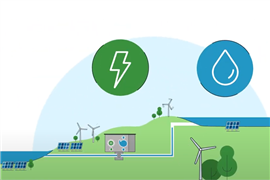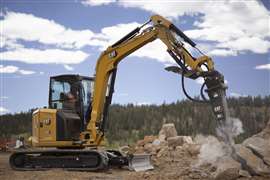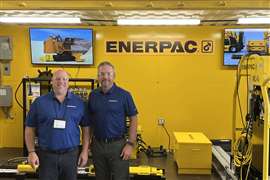Lights on: new LED, hybrid and solar powered lighting towers.
14 August 2013

Manufacturers are taking differing approaches to the technology of lighting towers, with LED lamps, solar power and hybrid energy solutions crowding in on the traditional metal halide, diesel powered towers. IRN reports.
The push into LED lighting towers continues, with almost all manufacturers now offering LED lamps as an option. LED lamps are attractive because, despite their relatively high initial cost, they last significantly longer than traditional metal halide lamps and also draw substantially less power, meaning than engines can be smaller and fuel use lower.
The latest big name to enter the LED fray is Spain’s Himoinsa, which is now offering an LED version of its Apolo Compact model. The Compact Eco has six 240 w LED light bulbs and will use 40% less energy than conventional towers and allows the company top use a smaller, 5 kW Yanmar L100N5 engine.
“We have waited until now [to offer LED towers] because we wanted to accurately identify the market's real needs and to launch new lighting towers that satisfy all the customer's requirements”, says Manuel Sánchez Bada, engineering area manager, Himoinsa.
“Our main goal over this period has been to ensure that the technology we launch meets the demands of our customers in terms of quality and robustness. We also wanted to ensure that we could source quality replacement parts quickly.”
The new LED towers are part of a general widening of the product range, with Himoinsa also adding a Compact Heavy Duty tower to its range, with the same lamps, tower and engine as the Compact but with a strengthened body for applications in the mining and oil and gas sector.
At the small end of the scale Himoninsa also launches the KT1000 Mini Kit, which is supplied without a power source; “In effect, the idea is for it to be able to operate with another external source or with another set”, says Mr Sánchez, “This has different advantages for some applications. Since it has no engine, it does not pollute and there is no noise if we supply it from the electricity grid, making it ideal for indoor use.”
Another company already offering LED lamps on its towers is Morris Site Machinery (formerly ArcGen-Hilta), the UK company that is now seeking international business for its range of SMC lighting towers.
The company’s chief executive, Chris Morris – part of the fifth generation of the Morris family now running the business - says the company has now finalized its export plan and will soon appoint a new international sales director to spearhead the effort in key markets; “Oil and gas and mining, these are the key industries that will require our equipment”, says Mr Morris, “In terms of territories, its South America -including Peru and Chile and possibly Venezuela – South Africa, the Middle East and Scandinavia.” Australia and New Zealand are also target areas for the company.
Morris is launching a new version of its SMC lighting tower called the Mine & Metro, with an 8 kVA Kubota power unit, which is a compact but heavy duty lighting tower with features that make it suitable for both mining and inner city applications.
“The Mine & metro represents a realm opportunity for growth”, says Chris Morris, “It was developed for the Australian mining sector, but can be applied anywhere.”
More generally, Morris has been one of those at the forefront of new technology, with its first solar powered tower launched two years ago and LED lamps also available for some time.
One technology being adopted by some companies is a hybrid solution, with batteries augmented by a generator. Chris Morris thinks this option will soon become obsolete as batteries become more efficient. “It’s a slightly compromised solution. The power required to charge the batteries is greater than if you were just running the tower.
“I think it will be obsolete pretty quickly, with batteries becoming more interesting. We’re not going down the hybrid route.”
Fuel cells are another option, with Youngman Group and TCP introducing a fuel-cell power tower at the UK’s Executive Hire Show earlier this year. Mr Morris thinks that refuelling issues mean that it is not a viable solution; “we’re open to new technology, but for the time being we’re not pursuing that option.”
Also being cautious on new technology is Atlas Copco Portable Energy. Although it introduced the QLTS battery and solar powered LED lighting tower at MINExpo last year, Ben van Hove, vice president of marketing at Atlas Copco Portable Energy, tells IRN that whole life costs are important for rental companies and that there has to be some security in terms of the technology being used; “There is still a high change rate in the technologies being offered…It’s important that when we do something we make sure it has added value for rental companies and that they can work with a machine for three to five years - that lamps are still available, for example - so that they can get a good second hand value.
“What is the right timing [to offer new technologies]? I think we are still seeing substantial changes in LED technology that will stabilise over the next two years. I think that might be a good time for us to have the right products.”
The solar tower unit is seen as a specialist, niche model and not as a replacement for its standard metal halide products, he says; “That product has been performing very well.”
Italian manufacturer TowerLight has been quick to see opportunities in new technology, whether using electronic engine controls to allow the use of smaller generators or adopting LED lamps.
The importance of being able to offer this kind of technology was illustrated recently when the company won an order for around 200 VB9 LED Hybrid towers to Speedy Hire for use at the recent Glastonbury Festival.
The festival organiser favours the use of ‘green’ equipment at the site, hence Speedy’s choice of the VB9 LED Hybrid, which uses a hybrid battery/diesel system, with auto charging technology with the set running on 90% battery power and 10% fuel.
The battery is automatically recharged via a low battery monitor system, combining 8 hours battery power and 8 hour generator usage. The battery has 3000 hours life and the generator consumes just 0.25 litres per hour when in use. The set can run for over 500 hours on a single tank of fuel. The towers were sold to Speedy by TowerLight UK, the UK subsidiary of Italian manufacturer TowerLight.
Paul Hay, managing director of TowerLight UK, says the company is pushing a ‘green three’ offering, with the VB9, its hybrid tower with LED lamps, and the LinkTower, which can be joined in series and powered by an external source.
Mr Hay says the hybrid concept still offers great opportunities “Hybrid is the way forward…in the next three to four years I see hybrid taking centre stage”. The company is working on extending its range of hybrid units.
The company also continues to expand its international footprint, having just signed an exclusive distribution agreement in North America with Bartell Morrison, the US manufacturer of concrete finishing equipment.
The two companies have been discussing a potential partnership for several months and Bartell showed one of the Italian-made lighting towers at this year’s Rental Show to test the market.
Jeff Durgin, president of Bartell Morrison USA, said; “TowerLight has put together the best combination of features and quality in the industry. The light tower market has become very competitive, and we chose a partner that can bring more than just a low price.
Other suppliers continue to expand their ranges. JCB Power Products, for example, is expanding its lighting tower range. The company is adding an LED model and a lower output 400 W unit, as well as two new towers, a skid mounted unit to reduce operating costs and a mains supplied unit for sites where noise and emissions may be a concern.
The new LT9 LED has six 240 W LED heads. JCB says LEDs provide 70% of the light output of the larger 1000 W metal halide lights but consume considerably less power, allowing the tower’s 400cc Yanmar engine to run for up to 150 hours on a single tank of fuel. JCB’s towers are understood by IRN to be made for it by Himoinsa, although JCB does not confirm that.
The LT9 ECO, meanwhile, uses four 400 W metal halide bulbs, producing 60% of the illumination supplied by the standard mast’s 1000 W bulbs, but requiring considerably less power.
The LTC9 lighting tower is skid-mounted, improving security on site and also reducing transport costs to and from sites. The LTC9 is available with the standard 1000W metal halide lights, the 400W ECO lights or the new LED lights.
The mains powered LTB9 is mounted on a base plate with four independent outriggers for stability, and is suitable for sites that have a stable electrical supply, either from a mains outlet or through on-site generators.
There are plenty of other new lighting products as well. Wacker Neuson’s new LBS 80M light balloon has a balloon design that is completely redesigned, the result being a reflective surface that Wacker says offers an optimal, glare-free illumination. The LBS 80M replaces the LB 1 unit.
The balloon, which provides light at a height of 5 m, can easily be tensioned with the help of a stretching mechanism and a single cable lock. Compared to its predecessor model, the tripod has increased robustness and stability thanks to its stronger material.
Also new from Wacker Neuson is the LTN 6LV, a “deluxe” version of the established LTN 6L. The V in the model name stands for the new tower design that allows the user to transport the light tower while the tower is in a vertical position. “Moving the mast into the horizontal position is unnecessary with the new light tower, because it has very compact dimensions in a lowered state”, says the manufacturer.
In the UK, Youngman Group has completed the development of a European trailer version of its TCP Ecolite-T lighting tower, equipped with an adjustable height hitch allowing it to be towed by a wide range of vehicles.
Although adding more than 10% to the cost of the Ecolite, the adjustable height hitch is important for markets including France and Germany. The new hitch also requires a strengthened frame, adding around 150 kg weight to the unit.
The Ecolite, which has been a popular lighting tower in the UK for many years, features auto on-and off- switching depending on light levels, a 170 hour running time on a single tank of fuel, and a bunded base offering 110% machine fluids containment.
Youngman sells the Ecolite worldwide through a joint venture with UK manufacturer TCP.
One of the first company to offer LED lighting towers was Terex Aerial Work Platforms (AWP). The company has now improved the product with the introduction of a ShorePlug connector. Standard on all new Terex AL4L generator LED light towers, the ShorePlug allows multiple light towers to be connected in-line and operate from a single power source.
Terex AWP says the ShorePlug feature “makes it quick and easy to take advantage of the power efficiency of these LED lights by safely and securely connecting multiple AL4L light towers in-line to operate from a single AL4L generator model.
“Powering multiple light towers with a single generator greatly reduces fuel consumption and engine noise when compared to operating metal halide light towers with individual generators.”
Meanwhile, Doosan Portable Power now offers the V9 light tower, comprising four 1000 W metal halide lamps rotatable through 350o provide a lighting power of 360,000 lumens. The mast is raised hydraulically to the maximum height of 9 m in just 10 seconds.
The V9 has an operating weight of 1263 kg and is equipped with a 6 kVA Mecc Alte LT3/130 alternator and two 16A auxiliary sockets. The V9 is powered by the Kubota D1105 diesel engine, giving 8.4 kW of power at 1500 rpm.
For markets in the Middle East and Africa, meanwhile, Doosan has introduced a 50 Hz version of its LSC (LightSource Compact) light tower. It also uses a Kubota engine, although a different model, the 8.5 kW D1005.
Finally, a new US company, Light Tower Solution (LTS), based in Dallas, Fort Worth, has just launched its LED product, the Lexin 300, which allows LEDs to be retrofitted to a conventional tower or fitted at the manufacturing stage.
LTS says the LED lamps will operate for more than 50000 hours and reduce fuel consumption by approximately 50%. It also says the benefits of LEDs include “a safer whiter light, less light loss, increases employees safety, provides available generator space for other uses, instant on/off capabilities and less light pollution”.
“Since its inception, the Lexin 300 has been purchased throughout the United States and some end users are now requiring the lights from their preferred rental company offer the Lexin 300”, says the company.
The first light tower will take two to three hours to retrofit, says the manufacturer, then soon after it should take around an hour. The company is now working with a number of light tower manufacturers allowing them to offer a LED light tower in addition to their current metal halide offerings.
OTHER LIGHTING TOWER NEWS
Verdegro in the Netherlands is an example of a company that only makes alternative power lighting towers, with a range of hybrid and solar powered models. There are four models to choose from, all with LED lamps: a 400 W version, a 1200 W model, a compact solar powered unit and a hybrid solar/Kubota diesel unit.
Allmand Bros Inc has introduced an iPad/iPhone App to allow users to calculate what lights they need for a particular application. Although developed and offered by Allmand, it can be used as the basis for setting up 1000 W or 1250 W metal halide light towers from almost any manufacturer. To download the App search for ‘Allmand’ in the App store.



